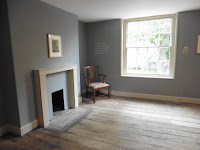My latest feature for
Jane Austen's Regency World (March issue) is on the art of paper-making. Paper was needed, of course, for Jane's letters, and for her books to be printed on.
Paper was commonly made from cotton or linen rags. Some of the process was already mechanized and powered by water - there were already paper-mills in the mid-eighteenth century - but it was a slow process. It could take up to three months to make one sheet of paper by hand, depending on its quality.
'Hot-pressing', as mentioned in Jane's novels, involved heating a sheet of writing-paper between cast-iron plates to give a nice smooth finish.
Louis-Nicholas Robert's 'continuous wire process' (1798) made it possible to make much larger sheets of paper by machine. Within a few years, the first paper made in a single continuous roll was made at Frogmore Mill in Hemel Hempstead.
The paper was also cut by machinery, tended by child workers.
And the more paper was made, the more novels could be printed!
Images from the author's collection:
Top left: Paper making by hand at Hollingworth's Turkey Mill, Maidston, Penny Magazine, 1833.
Centre: Paper-cutting machine with child workers, Monthly Supplement of the Penny Magazine [96], 31 August to 30 September, Charles Knight, London, 1833.
Image right: Dennison (Denison) and Harris’s Patent Paper-Making Machine, patented 1 January 1825. Luke Hebert, The Engineer’s and Mechanic’s Encyclopedia, Vol. II, Thomas Kelly, London, 1836, Nigel Wilkes Collection.














